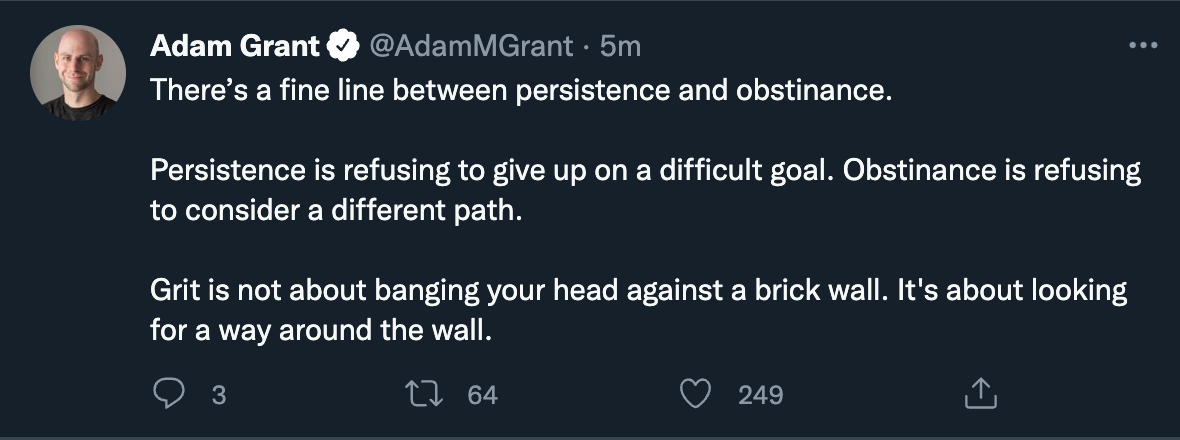Sometimes, Quitting is the Best Choice. Learn How to Become a Strategic Quitter
Quitting isn't always a bad thing. In fact, it sometimes it's the best choice.

In my previous article, What Motivates You? Learn the Types of Motivation and How to Use Them, I shared the first part of my experience climbing Mount Fernie. I dug into intrinsic and extrinsic motivators as I reflected on the many decision points I had along the way where I considered turning back, but instead, pushed forward.
I left off having made the decision to finish the hike…
About 90 minutes in I may or may not have muttered,
“What did I think I was a 🤬 mountain goat?!!”
The terrain had become increasingly rocky and there were several points where the trees cleared and I could see the town of Fernie going about its business far below me.
I came to a set of large rocks with no clear path and then, just beyond the rocks, an area where I would have to scramble (scrambling is a walk up steep terrain involving the use of your hands). It was steep and rocky with loose shale.
I had known there was a section that would require scrambling right before the summit, having read about it while researching the hike. I told myself (while sitting in the comfort of my home in Edmonton about 600km away), that scrambling was no big deal.
But as I looked down at my now filthy runners, huffing and puffing, my quads and calves screaming, and recalled the hiking poles I was offered but forgot to bring on the trip… I called it done.
I was alone at the top of a mountain, tired, and without equipment suited for scrambling. The scramble was an unnecessary risk for what was a similar view to what I was already experiencing, with no other real reward.
I decided I could skip the last scramble to the top with my pride intact and that it was not a life choice I was going to regret.

I found a spot where I could safely take a seat and enjoy the beautiful view. I had an apple and some nuts and thought about the pizza I was going to enjoy (my extrinsic motivator!) when I made it back to the house. I was proud of myself for making it this far, and apparently, in a lot less time than it was supposed to take (intrinsic motivators!).
I started the descent shortly thereafter. It was faster but no less difficult than the ascent. My glutes and knees joined the symphony of angry bits and protested with fervour, promising revenge the next day (which they took!).
I eventually made it to my too-hot car 2.5 hours after I left it.
After a quick drive back to the house and rinsing off an exceptional amount of trail dirt, I promptly ordered myself the pizza I’d been thinking about for the past several hours.
I was bone tired but felt good about my decision to keep going on the hike AND my decision to quit when I did.
The pizza was amazing!🤤🍕

The vilification of quitting
You’ve probably heard variations of: “Never give up” or “Winners never quit and quitters never win”.
These are familiar refrains in fortune cookie tweets and Instagram posts with inspiring scenery.
The problem with these types of platitudes is they make quitting synonymous with failing. When quitting is seen as a failure, it creates pressure to push forward no matter what. You are told over and over that you have to have “grit” and that your persistence and perseverance will pay off.
In many situations, this is true, but there needs to be an asterisk added with a reminder that there is an important (oft-ignored) place for quitting when we make decisions.
There is a difference between quitting because something is hard, and quitting when something isn’t working. There is value in not giving up when the going gets tough, but there is equal value in evaluating what you gain (and more importantly) what might you lose by “persevering”.
Social psychologist, Adam Grant, frames the difference as one of persistence versus obstinance:
“Persistence is refusing to give up on a difficult goal. Obstinance is refusing to consider a different path.”
Sometimes quitting is the best choice
In my previous article, I declared: “I’m not a quitter” as one of the motivators for me to continue the hard climb up the mountain. Now I will add the asterisk that I am not a quitter… unless it’s the right thing to do!
My decision to quit at the scramble and not go to the summit did not make me a failure. I evaluated the potential risks and gains and decided that the risk was higher than the reward. In this case, quitting was the best choice for me.
There are a million reasons that you might quit something. It might be:
- A relationship that isn’t working.
- Letting go of an employee that doesn’t fit into your company culture.
- Stopping violin lessons because you don’t enjoy them and you dread them every week.
- Deciding to shut down your business because it’s making you miserable.
- … and countless other examples.
Grant adds,
“Grit is not about banging your head against a brick wall. It’s about looking for a way around the wall.”
More often than not, quitting is deciding on a different path forward.

How do you decide when to quit?
While I was working on this article I came across a serendipitous podcast. It is an interview on the Unleashed podcast with Annie Duke, who recently wrote the book, Quit: The Power of Knowing When to Walk Away. In the podcast interview, she touched on three ways to reframe how you think about quitting and some things you can change:
1. Avoid getting caught in the Sunk Cost Fallacy
The Sunk Cost Fallacy is “our tendency to follow through on an endeavour if we have already invested time, effort, or money into it, whether or not the current costs outweigh the benefits.”[1]
For example, you registered and paid to attend a virtual course. Just 15 minutes into the course you realize the speaker is terrible and you don’t believe you will get anything out of it. Instead of quitting and doing something more productive, you stick with it because you don’t want the amount you paid to “go to waste”.
When you think about quitting something, consider the risks and rewards of going forward instead of what has already been done or spent.
2. Establish kill criteria and an accountability buddy
Kill criteria are the metrics or circumstances under which you will “kill” (quit) a project or commitment. When you start something, think about what would need to happen for you to decide to quit AND tell someone else. An accountability buddy to remind you of the kill criteria helps you avoid the sunk cost fallacy and reconsider the options for a different path forward. They also help you keep going if you haven’t hit those kill criteria.
For example, let’s say you are playing poker with your friends. It’s a friendly home game with a $20 buy-in. You decide your kill criteria is, if you lose that $20, you will be done for the night. You tell your partner this and, when you consider buying back in for more money after losing the $20, they remind you of your kill criteria.
We always establish kill criteria when we have strategy discussions for new startups or projects in my software business as well.
3. Don’t start with the “low-hanging fruit”
Low-hanging fruit are the easy tasks or parts that you get out of the way before deciding to move on to the more difficult things. This is another way of saying what I mentioned in previous articles on prioritization: Don’t clear the decks, Eat the Frog!
You get a false sense of progress when you start with the low-hanging fruit. Instead, when you start with the more difficult aspects of a project or endeavour you have more information on whether it’s worth your time and effort. You also don’t waste your best energy on the easy tasks.
For example, you decide you want to write a book. You brainstorm working titles, take a course on how to write a book, order books about writing books, ask your friend who has written a book about their experience, and start telling people you are writing a book… but you haven’t written a word.
The small, safe things are fun and easy, and make you feel like you have made progress, but the hard part, and where you need to start, is with the writing.
Become a strategic quitter
Part of living with intention is regular (daily!) reflection on your behaviours, feelings, goals, and values. Through your reflection, you have the information necessary to evaluate if the things you invest your time and energy into are in alignment with what you want. There are plenty of things in life that you need to push yourself to stick to and have the grit to keep going when they get hard… but there are plenty of things that are also not a good investment of your time and energy.
There will often be a better path so remember to take the time to notice if something is worth your time and energy.
Become a strategic quitter:
- Start with the hard stuff
- Identify what would make you quit (your kill conditions)
- Tell a friend or colleague the parameters you have set (your accountability buddy)
- And if you feel hesitant to quit something because you have already invested time/energy/money, remember the sunk cost fallacy
Be persistent but not obstinate. Work hard, and push forward, but know when to quit.
Need some help learning how to be a strategic quitter? Get in touch!
Share
Ashley Janssen

Productivity consultant, writer, speaker, serial entrepreneur, chaos calmer, introvert, cat-lady. Lover of books, fitness, old fashioned’s, basketball, and video games.
Follow me on
Twitter
or
LinkedIn.
Hire me for
1 on 1 productivity consulting
or
speaking.
Related articles

Why Are You Productive For "Only" 5-6 Hours Each Day?

When You Do Things Matters


Comments ()